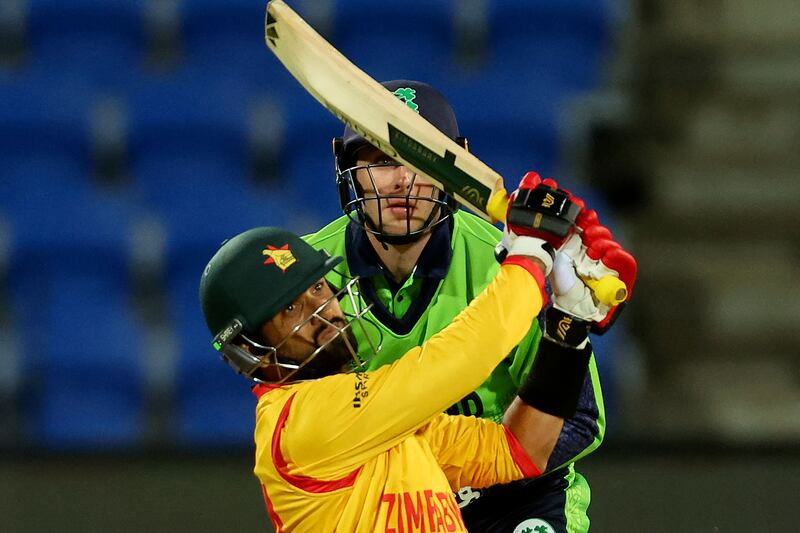The ominous feeling around the Bellerive Oval was impossible to ignore. In the 13th over with plenty of time left to bat, Zimbabwe’s Sikandar Raza, catalyst for his side’s win over Ireland, brought up his half-century off just 26 balls.
The milestone came via a monstrous heave over long-on, the longest boundary in the ground. Leg-spinner Gareth Delany was the victim. Two balls later another strong drive straight back, this one flat and along the ground, raced into the long-off boundary.
An over later, Raza carted a short ball from Simi Singh high over the midwicket fence. In that two over-spell, the Zimbabwean all-rounder had taken Ireland’s spinners with him on a tour of Hobart, offering little opportunity to a section of the attack tasked with taking wickets during the middle overs.
[ Raza heroics send Ireland to opening defeat at T20 World CupOpens in new window ]
It isn’t the first time a lack of an incisive edge with the ball during that middle period has cost Ireland this year. Usual strike bowler Josh Little can’t be relied upon to take a wicket in the 10th or 11th over of every match — though he tried to prove he could against Afghanistan in August — and while Delany in particular has shifted his attitude to a more attacking, dismissal-orientated game plan, he too will not deliver on each occasion.
Ken Early on World Cup draw: Ireland face task to overcome Hungary, their football opposites
The top 25 women’s sporting moments of the year: 25-6 revealed with Mona McSharry, Rachael Blackmore and relay team featuring
World Cup 2026 draw: Team-by-team guide to Ireland’s opponents
Irish rugby is a good place to be, thanks to people such as Dave Fagan
“We’ve always spoken about how that [the middle overs] is where the game is won or lost,” explained Ireland captain Andrew Balbirnie after Monday’s defeat. “In the power play, anything can happen either way but that middle period is the real time to strike, we want to use our seamers in that period rather than save them to bowl all their overs at the death.
“We weren’t able to get any wickets in that period [in the defeat to Zimbabwe] which cost us a bit but we’ll continue with that aggressive mindset.”
Monday’s aggressive search for middle-overs wickets yielded little return as Raza turned the game on its head. Was there another direction Ireland could have turned?

George Dockrell is one name that springs to mind.
Since taking 2-7 in the 1st T20 against Afghanistan in August, the Leinster all-rounder has not bowled. There have been six Ireland games since then.
The side prefers to use Delany as an option to move the ball away from right-handers and Ireland have outlined their preference for consistency both when it comes to selection and player roles.
Yet Raza’s numbers suggests a trick may have been missed with Dockrell’s left-arm laying idle.
In his T20 international career, his strike rate against leg-spin, Delany’s craft, is 124 and he has been dismissed by such bowlers six times in 140 deliveries. Against left-arm spin, what Dockrell could have offered, Raza strikes at 82 and has been dismissed nine times in 139 balls. When playing off-spin, his strike rate of 117 is low but he rarely loses his wicket (four times in 129 deliveries).
Raza scores his runs slower against left-armers and has been dismissed more often by them. Given that data, Dockrell must have been chomping at the bit to get the ball, especially when he saw Raza launch both Singh and Delany towards Bellerive beach. If anything else, just to try something different since seam wasn’t working either.
He was, of course, diplomatic when asked that question.
“As always, I’ll be ready with the ball if Andy [Balbirnie] needs, if that’s an option,” said Dockrell on Tuesday in the lead-up to Wednesday’s must-win clash with Scotland. “I’ll keep chipping away in training and make sure I’m ready if a chance comes.
“I know Nathan [Hauritz, Ireland’s spin coach] has been backing me since he’s come on board, and he’s been fantastic, I think, for all the spinners.”
Raza’s innings, special as it was, is done and will be moved to the side given the quick turnaround before the Scotland game. They too, though, have a key batter whose weakness against left-arm spin could well be exploited.
George Munsey, who hit 66 not out in Scotland’s win over the West Indies on Monday, defies conventional logic as a left-handed batter. He should be strong against left-armers turning the ball into him and weak against off-spinners moving it away.
The reverse is true. Against left-arm spin, he strikes at 127. Against offies? 165, thanks largely to a strong reverse-sweep that flays the ball with the movement provided by off-spinners.
The recent sample size also suggests attacking him with left-arm is the way to go. Against the West Indies, Munsey started his innings sedately with two off seven balls, thanks largely to five dots bowled at him in a single over by left-armer Akeal Hosein.
“Munsey played well on Monday,” agreed Dockrell. “He is quite a unique batter in the way he plays, probably both seam and spin, [he] hits the ball in slightly unconventional areas. But I think that’s probably why he’s had some success.
“Look, we’ll have our plans to him, and as always, if there’s an option for me to chip in, then I’ll be ready to go.”
Ireland’s success or failure won’t depend on one bowler coming into the attack. Losing four wickets in the power play against Zimbabwe was the bigger issue in terms killing the game off. Yet using Dockrell could well give them a fresh edge in that search for a greater middle-over wicket threat, one the skipper himself labelled as crucial.






